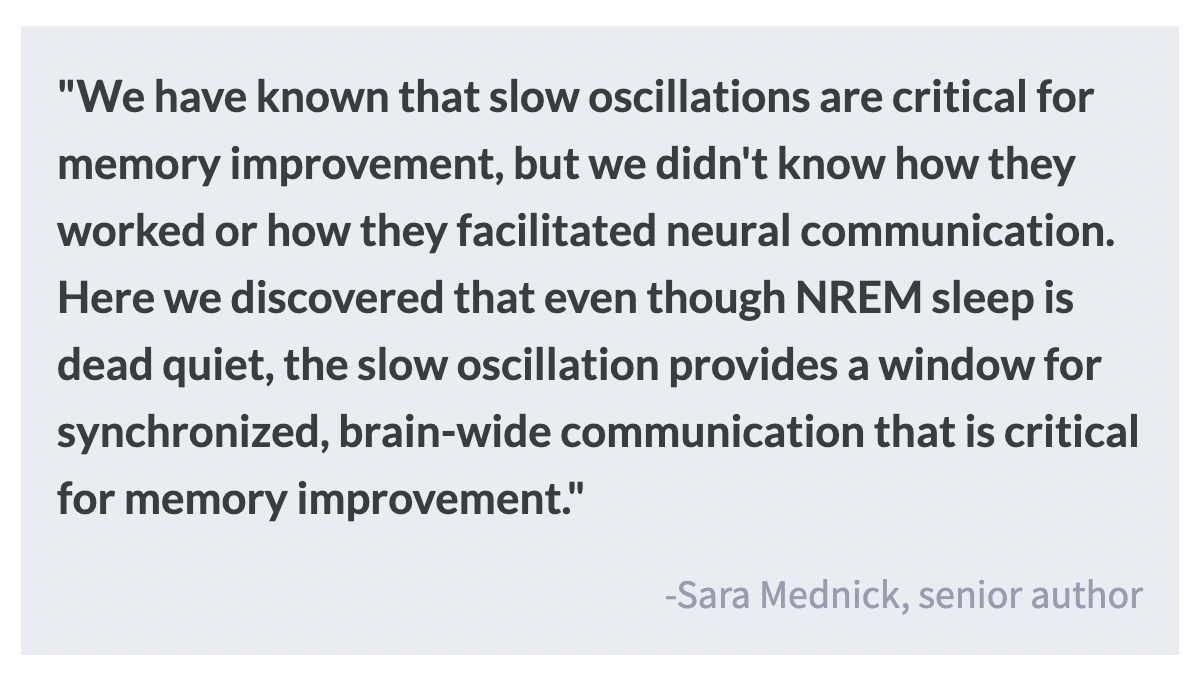Slow Oscillations Facilitate Brain-Wide Communication and Memory Consolidation During Sleep
Post by Lani Cupo
The takeaway
Coordinated waves of global brain activity play an important role in memory consolidation and information flow during non-rapid eye movement sleep, a sleep phase otherwise characterized by dampened activity.
What's the science?
Previous research shows that non-rapid eye movement sleep (NREM) is important in the consolidation of memory, possibly through waves of coordinated activity across the cortex called slow oscillations. However, evidence also suggests that NREM is characterized by a loss of network connectivity, which seems to be in opposition to the role of this sleep phase in memory consolidation. This week in PNAS, Niknazar and colleagues used electroencephalography (EEG) in healthy young adults to investigate the causal function of slow oscillations on the direction of information flow and on memory.
How did they do it?
The authors conducted a sleep experiment where 59 healthy young adults underwent EEG. Participants completed a memory test (word pair associations) before and after sleeping. During sleep, they wore an EEG cap measuring brain activity with electrodes at 32 different locations, or channels (10 for reference, 22 for recording). Data from the 22 channels were examined to identify the presence of slow oscillations, and data from 12 channels (three each in the frontal, parietal, temporal, and occipital lobes) were analyzed to establish the direction of information flow. Of these 12, data from four channels were considered as potential “sources” of activity, while all channels were considered potential recipients, or “sinks”. When patterns of slow oscillations were detected near the source channels, the authors used a mathematical model (generalized partial directed coherence) to compare waves of activity following the activation throughout the other electrodes. They examined how the magnitude of information (captured by the height of peaks) was impacted by the distance of the source to the origin of the slow oscillation, how much signal at sinks was impacted by the distance of the sink from the origin of the slow oscillation, and how much other factors impacted the flow of information. Then, the authors tested the hypothesis that global slow oscillations facilitate more information flow than local slow oscillations. Finally, they examined whether information flow associated with slow oscillations impacted memory performance on the post-sleep test.
What did they find?
First, the authors found that NREM sleep is indeed a period where neural communication is very low. However, slow oscillations allow for widespread communication across the whole brain. During this burst of causal information flow, the position of the slow oscillation impacts the magnitude of information flow, with the source channel closer to the oscillation sending the greatest magnitude of information and sinks farthest from the oscillation receiving the greatest magnitude of information. For example, if a slow oscillation was detected in the frontal lobe, a source electrode in the frontal lobe would show more outgoing information compared with one in the parietal lobe, and a sink at the occipital lobe (far away) would receive more information than one at the central channel. This suggests that slow oscillations are promoting large waves of long-distance brain communication. Supporting this result, the authors found that global slow oscillations that propagate across more electrodes allow for greater information flow than localized ones.
Finally, investigating the impact of information flow on hippocampal-dependent episodic memory, global slow oscillations also facilitated greater improvement, while local ones only facilitated improvement when the source electrode was close to the source of the oscillation and when there was greater distance between the source and sink pair.
What's the impact?
These findings begin to reconcile disparate findings in the field—namely that NREM sleep is characterized by dampened activity, yet seems to underly the consolidation of episodic memory. This research provides evidence that bursts of long-range communication during slow oscillations allow memory consolidation to occur during NREM sleep.


